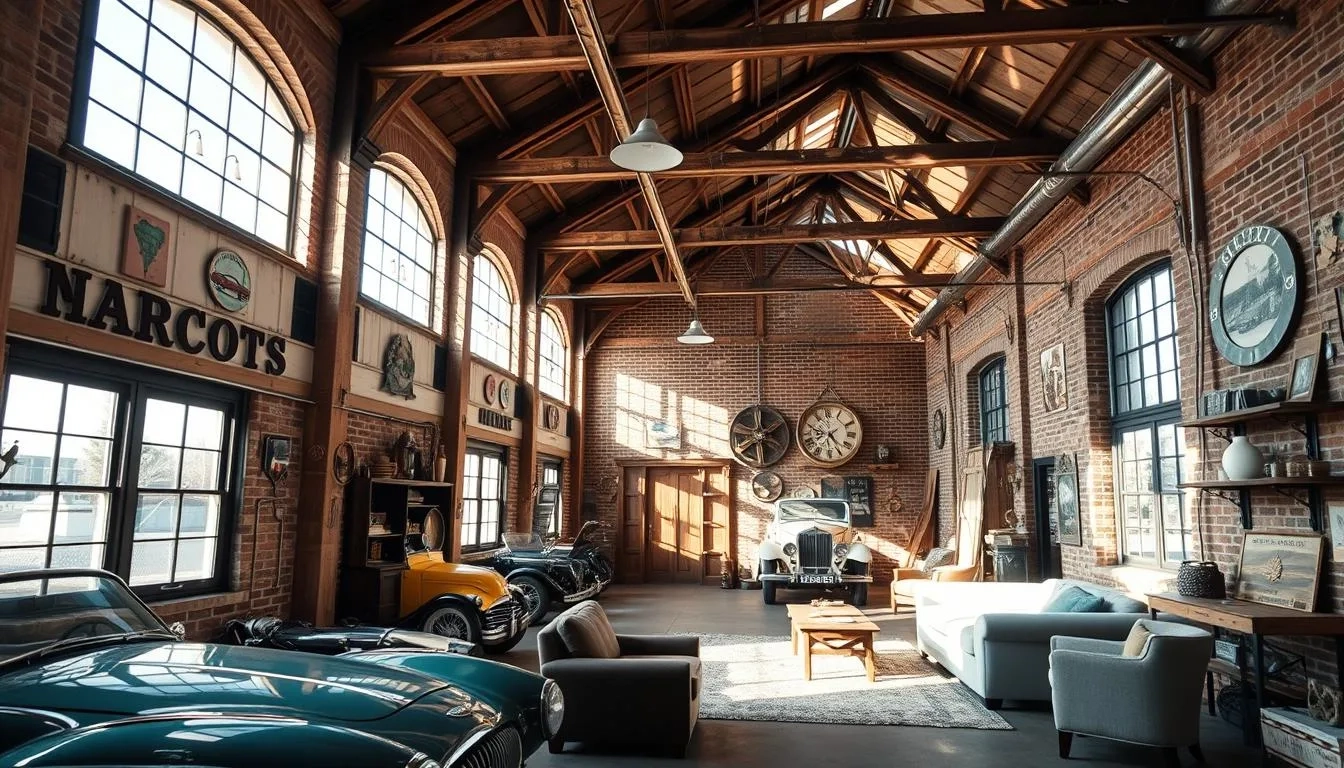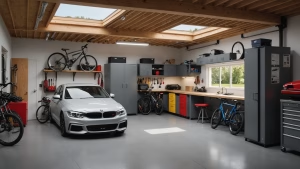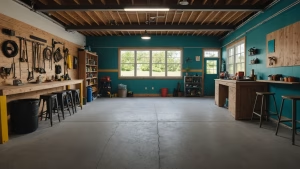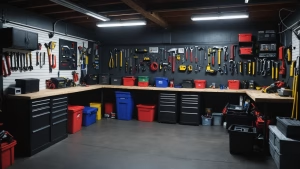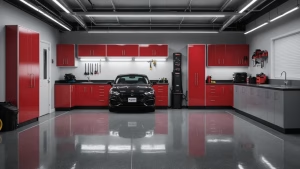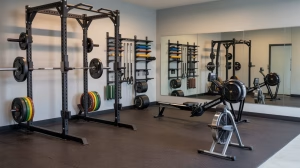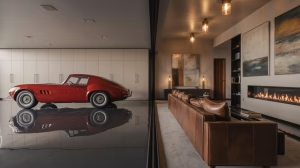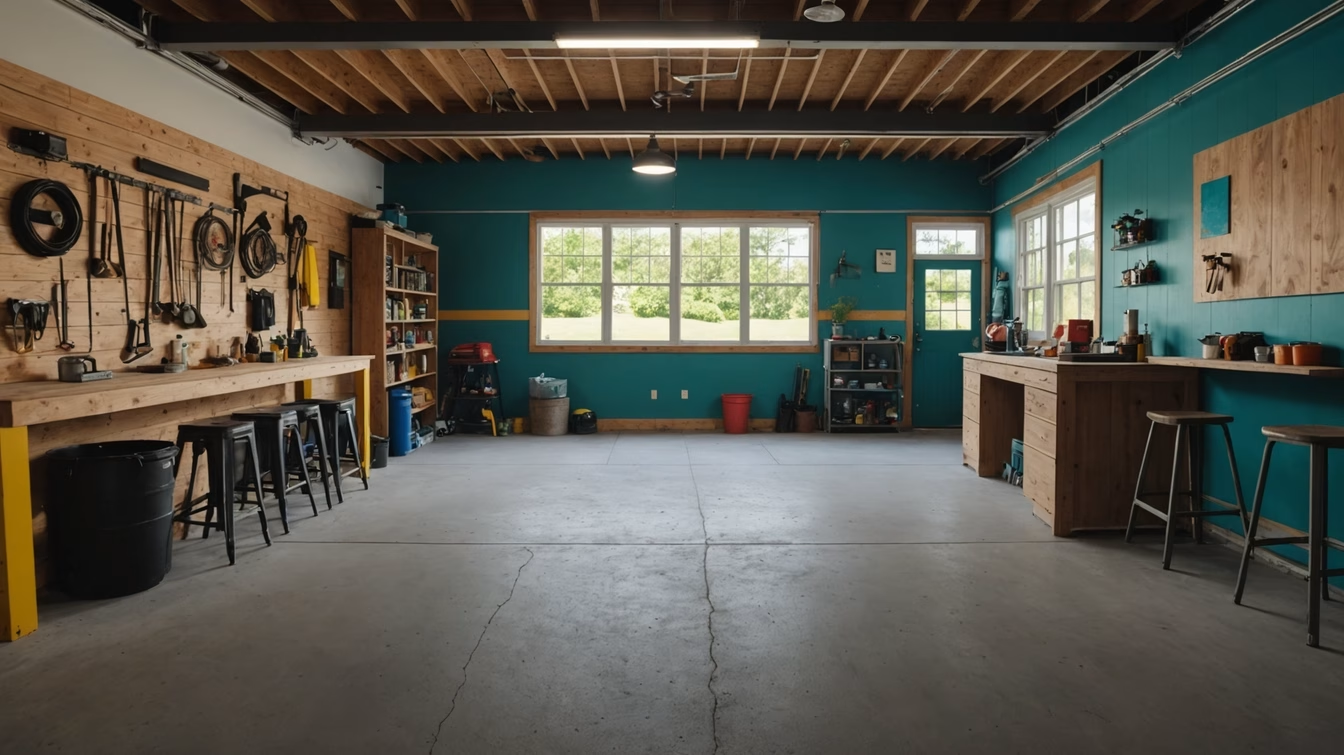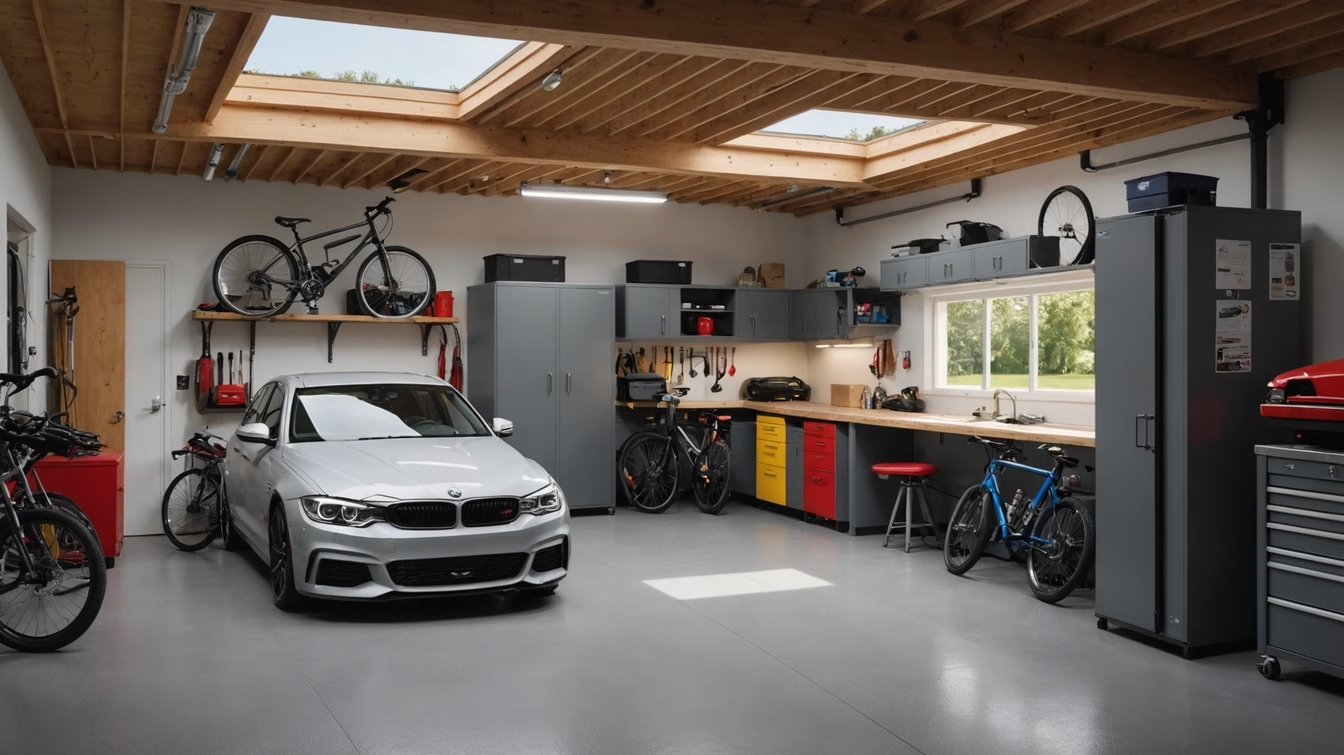Historical Garages in the Twin Cities merge Craftsman-era charm with Mid-Century Modern simplicity. They show that vintage car storage can influence today’s design trends. Originally, these garages stored horse-drawn carriages and early autos. Now, their distinctive arches and wooden facades inspire modern updates.
Today’s renovations incorporate carriage-house hardware and stained glass motifs. Yet, they also include modern insulation and automated systems. Companies like Door Power create steel garage doors with classic grids but with today’s energy efficiency. This blend respects history while meeting contemporary storage and technology demands.
The Allure of Historical Garages
Historical garages captivate with their unique blend of functionality and nostalgia. These spaces, once simple automotive havens, now symbolize eras where craftsmanship was the hallmark of progress. The 1909 Autocar coal truck and the 1923 Buick are examples of how these structures were the cradles of innovation in transportation. Their weathered exteriors and cluttered interiors narrate tales of hands that built engines and dreams.
Today, restoring these garages is a tribute to their heritage. Restorers meticulously preserve wooden beams and ventilation systems, merging modern efficiency with historical details. In Appalachia, early 20th-century farm trucks, such as the 1941 Autocar telephone truck, marked a significant shift from horse-drawn to motorized transport. These vehicles, restored with modern engines but retaining original paint, serve as a bridge between the past and present.
The cultural significance of these spaces is profound. A 1964 Pontiac GTO or a 1967 Dodge Challenger R/T 440 in a heritage workshop is more than just a vehicle—it’s a living museum of innovation. Todd’s collection, built over five years of research, includes such treasures, highlighting how restoration can revive automotive history. The transition from lacquers to ceramic coatings in restoration reflects the ongoing quest to merge old with new.
These garages are not just repair spaces. They are treasured family heirlooms, passed down through generations, teaching the value of perseverance and ingenuity. The presence of a 1973 Corvette or a 1964 GTO in a preserved garage evokes memories of a time when cars represented freedom. This blend of nostalgia and practicality ensures historical garages remain a vital part of America’s automotive heritage.
Common Features of Historical Garages
Historical car barns and antique car storage facilities showcased unique architectural traits. Many featured wide overhead doors, originally for horse-drawn carriages, later adapted for cars. Exposed wooden beams and large windows allowed natural light, while durable concrete or stone floors resisted oil and debris.
Original hardware, like heavy-duty hinges and latches, remains a key design element worth preserving.
Functional elements included built-in workbenches and tool storage, reflecting their role in early automotive maintenance. Regional styles varied: Midwestern garages often used clapboard siding, while Craftsman-era structures featured stone accents. The 1908 Sears Roebuck portable garage kit exemplified early standardization, with pre-cut materials for DIY assembly.
Preservation focuses on maintaining original materials. For example, restoring wooden framing and adding modern insulation under vapor barriers balances historical charm with functionality. Period-appropriate details like wrought iron fixtures or wooden doors keep the garage’s heritage intact. Understanding these features helps homeowners prioritize elements worth saving during renovations.
Transforming Historical Garages for Modern Use
An old Vancouver garage, once a haven for spiders and dust, now thrives as a writer’s studio. Such transformations illustrate the power of classic car garage restoration and traditional garage renovation. They redefine spaces while respecting their historical roots. Modern touches, like updated wiring and insulation, can merge with the original architecture seamlessly.
It’s essential to focus on functional upgrades while preserving key elements. This might include original wood beams or vintage door hardware. This approach ensures the garage retains its historical charm while meeting contemporary needs.
Turning garages into home offices, studios, or even “gar-bars” demands a balance between beauty and utility. For car aficionados, retro vehicle preservation is a top priority. Climate control systems safeguard antique cars, while hidden EV charging stations or car lifts add convenience.
Using reclaimed wood and low-VOC paints keeps the renovation eco-friendly. This aligns with the growing trend of sustainable traditional garage renovation.
Contractors like Andrea McLean advocate for keeping 50% of original features to maintain authenticity. This not only respects history but also increases property value. Historic renovations with preserved details can see a 20% higher resale value. Whether for work, hobbies, or storage, thoughtful design keeps these structures functional and a testament to the past.
Preservation vs. Renovation: What to Consider
Deciding whether to preserve or renovate a historical garage hinges on its historical importance. The age, architectural style, and local historical ties are key factors. For example, garages tied to significant events or architects might need full preservation. Others could be transformed into modern spaces, like heritage automotive workshops.
Researching through local records or historical societies can reveal a structure’s rich history. This information guides decisions on how to renovate traditionally.
Restoring heritage automotive workshops aims to keep original features intact. Yet, adaptive reuse combines old and new elements. McLean’s project, for instance, turned an early 20th-century garage into a modern space. It retained the original design, blending history with functionality.
Such projects not only respect history but also meet contemporary needs. They boost property value and community identity.
Local regulations, such as Certificates of Appropriateness, ensure changes respect preservation goals. Preserving historical garages also fosters tourism and job creation, as seen in West Palm Beach. This balance creates spaces that honor the past while meeting today’s needs.
Historical Garages in Popular Culture
Historic automobile garages and vintage car storage spaces have long fascinated storytellers. Films like *Back to the Future* and TV shows such as *Mad Men* showcase garages as symbols of innovation and nostalgia. The HP Garage in Palo Alto, California, where Hewlett-Packard began, now serves as a museum, blending history with cultural legacy. These spaces are often depicted as hubs of creativity, like in *Parks and Recreation*, where garages symbolize grassroots entrepreneurship.
Authors and artists also celebrate historical car barns. Novels like *The Amazing Adventures of Kavalier & Clay* portray garages as workshops where dreams take shape. Photographers like Julius Shulman documented mid-century garages, capturing their evolution from simple sheds to status symbols. Modern media amplifies this through Instagram accounts and shows like *Motor Trend*, which profile historic car barns as cultural landmarks.
From 1950s Americana in *Mad Men* to the HP Garage’s tech origins, these spaces reflect societal shifts. Their presence in pop culture reinforces their role as more than storage—they’re canvases for storytelling and identity. As both functional and symbolic, historic garages endure as icons of ingenuity and heritage.
The Impact of Historical Garages on Property Value
Historical Garages can significantly boost property value when preserved or renovated thoughtfully. In districts like Cleveland’s Jones Home Subdivision, over 297 garages contribute to historic character, making properties more appealing. These areas often command premium prices due to their cultural significance. For instance, the Lead Historic District in South Dakota shows that non-contributing garages—those not aligned with original design—reduce marketability, while restored structures attract specialized interest.
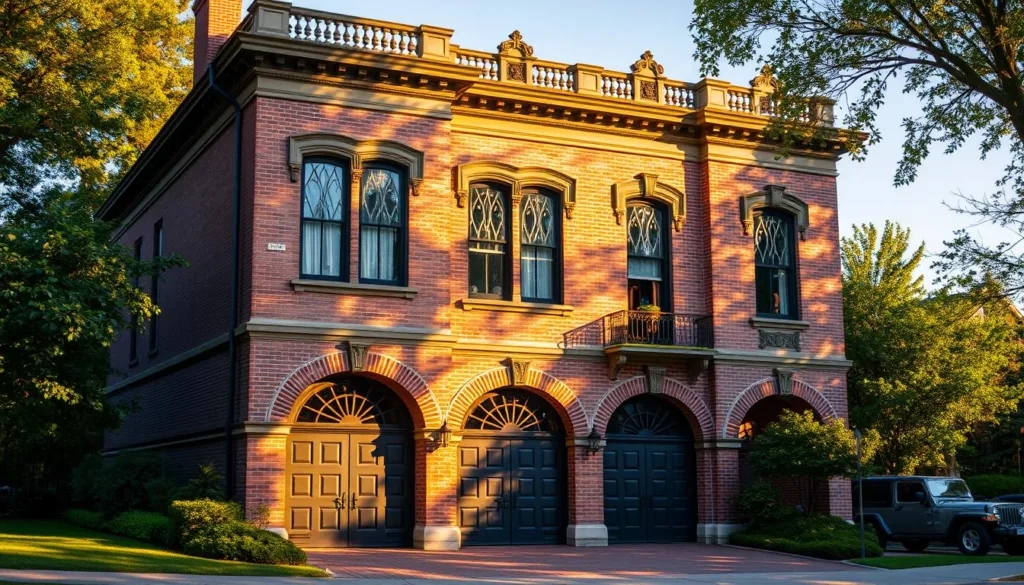
Classic car garage restoration projects, though costly, can yield high returns in regions with auto enthusiast communities. Traditional garage renovation that balances historic details with modern needs—like climate control or workshop spaces—typically offers better ROI. Data from early 20th-century garages, such as heated structures noted in 1913, highlight timeless features buyers prioritize.
Research shows homes in historic districts with maintained garages see higher resale values. In Wisconsin’s West Hill District, even incomplete surveys acknowledge that well-preserved garages draw interest. Investors should focus on functional upgrades like electric systems while retaining original elements. Marketing materials should emphasize how these spaces blend heritage with practicality, appealing to collectors and preservationists alike.
Iconic Historical Garage Models Worth Mentioning
Historic automobile garages, such as Nicola Bulgari’s Siena facility, showcase the pinnacle of antique car storage. This Italian garage is home to over 27 American classics from the 1930s-40s. It boasts shiny epoxy floors and specialized lifts, housing rare Buicks and Cadillacs. Master restorers maintain these vehicles, also training apprentices in vintage car upkeep.
Jay Leno’s collection, featuring a 1928 Bentley Speed 6 and a 1960s Lamborghini Miura S, exemplifies vintage car storage innovation. His garage uses climate-controlled spaces and high-tech lifts. Ralph Lauren’s NYC garage, with its 1929 Bentley Blower, combines luxury with practical storage solutions.
Early 20th-century Sears Roebuck kit garages made car storage accessible through pre-fabricated designs. Wealthy estates, on the other hand, built custom facilities that matched mansion aesthetics. George Barber’s Birmingham museum, housing 1,000 motorcycles, demonstrates how historic garages can become public attractions. These examples illustrate the diverse storage needs that influenced architectural trends, from 1930s carriage conversions to mid-century suburban garages.
Color Schemes Inspired by Historical Designs
Choosing colors is essential in keeping the authenticity of Historical Garages. Whether it’s restoring a heritage automotive workshop or a retro garage, using period-accurate colors adds to the historical charm. Early 20th-century garages favored muted earth tones. Mid-century retro vehicle preservation spaces, on the other hand, showcased bold hues like Jade Dragon and Torchlight. Modern paint collections, such as the Historic Paint Color Collection, provide exact formulations for authentic results.
Victorian-era designs employed warm tones like Golden Retriever and Greener Pastures, complemented by stained wood accents. Craftsman garages balanced Show Stopper reds with cool neutrals like English Channel. Spanish Revival styles featured Sweet Molasses and Polished Pearl for exterior accents. Colonial schemes often used muted Claret or Williamsburg Wythe Blue to reflect historical pigment availability.
Modern renovators can blend tradition with practicality. The Charming Contrast collection uses three-hued harmonies, like Onion Powder and Ancestral, to mimic old-world garages. Exterior ceilings often use Azalea Leaf PPG1149-6, while ornate trim benefits from bright whites. The Rich, Warm Paint Colors category includes 11 options for walls, while Classic Cool palettes offer natural greens and blues. These choices ensure garages feel historically accurate yet functional.
Reference the Historic Paint Color Collection’s 11 refined neutrals or mid-century trios like Close Knit for heritage automotive workshop interiors. Prioritizing undertones and light reflection maintains authenticity—key for retro vehicle preservation projects. Thoughtful color selection bridges past and present, making each garage a timeless tribute to its era.
Sustainable Practices for Renovating Historical Garages
Modern sustainable upgrades can seamlessly blend with the preservation of historic automobile garages. The 1913 Myrtilla Miner Building exemplifies this, combining insulation and green roofs to merge old and new. Reclaimed wood and low-VOC paints help maintain the original charm of historical car barns while reducing environmental harm. The Chapman Stables renovation showcases how planted rooftops manage stormwater, adhering to modern codes without altering the historic facade.
Insulation tailored to historic walls enhances energy efficiency. Radiant-heat tile floors in garages reduce energy consumption, protecting vehicles from rust and moisture. The use of recycled materials, such as salvaged wood trim or restored windows, keeps projects authentic while achieving eco-goals. The District of Columbia’s HPRB demands this balance, ensuring compliance with preservation and sustainability standards.
Installing EV charging stations aligns with the 2030s’ expected shift to electric vehicles. Federal tax credits cover 30% of charger costs, supporting historic car barn owners. Insulated garage-house walls also lower home energy bills, a feature highly valued by buyers. Water-conserving fixtures and solar panels further enhance the eco-friendly nature of traditional garage renovations.
How to Find Inspiration for Your Project
Begin by exploring historical car barns and heritage automotive workshops for design inspiration. Visit local archives or join groups like the Antique Automobile Club to study vintage garage layouts. Resources like SteelMaster’s Quonset huts illustrate how 1940s industrial designs can inspire today’s builds. For instance, Wayne MacDonald’s 1920s-style garage combines classic elements with modern materials, such as insulated steel panels.
Utilize online databases or architectural history books to track classic car garage restoration trends. Garage Living’s 1,600 sq.ft. projects showcase how to blend storage with style. Homeowners in areas prone to hurricanes, like Carl, demonstrate how to merge aesthetics with practical needs, like weather-resistant steel. Visiting museums or preserved garages allows you to see original features firsthand.
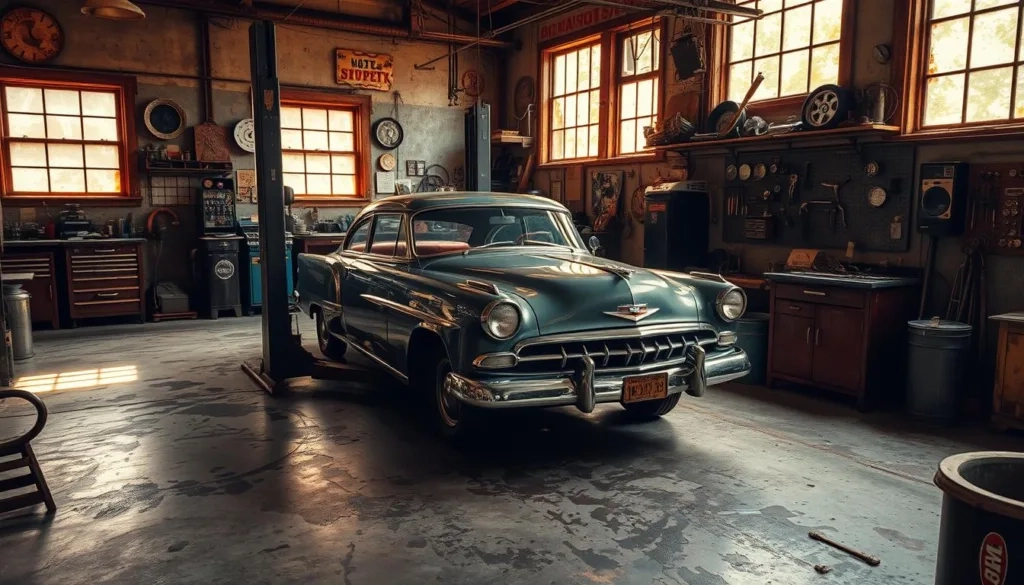
Create inspiration boards with photos of heritage garages or salvage items, like vintage windows. SteelMaster’s prefab kits, praised by clients like Carlos B., provide cost-effective ways to replicate historical designs. Follow builders who adapt classic elements, such as slatwall panels or Nardo Grey color schemes, to modern spaces. Join forums or local car clubs to connect with experts in classic car garage restoration and share ideas.
Tips for Documenting Your Renovation Journey
Every garage renovation has its own unique story. Begin by capturing original details such as door frames or flooring before any changes occur. Record the dimensions of spaces, like the 7-foot width of the author’s garage, and note the materials used in repairs. These records serve as a foundation for preserving retro vehicles.
Track your decisions on insulation or waterproofing, like the failed $5,000 contractor attempt. This helps avoid repeating costly errors. Documenting these choices is essential for future reference.
Share your renovation updates on forums or social media to connect with vintage car enthusiasts. Platforms like Reddit’s vintage car communities appreciate authentic stories. Share your struggles, such as the author’s flooding issues or the $20,000 budget overrun. Documenting these challenges helps others plan more effectively for similar projects.
Include before-and-after photos of your garage’s transformation. Show how a cluttered space became a functional vintage car storage area. This visual documentation is invaluable.
Adhere to Historic American Buildings Survey (HABS) guidelines for accuracy. Note paint colors, electrical upgrades, or plumbing additions, such as the added sink. Even small details, like the original 28-foot depth, are important. A well-documented project might even qualify for local preservation awards.
Every photo and cost log adds to the legacy of your garage’s transformation. These records protect both your investment and the automotive history.
Engaging with the Community around Historical Garages
Preserving historical garages is more than just fixing structures; it’s about building connections. Local historical societies and preservation groups provide invaluable resources for these projects. For example, Pittsburgh’s 1908 commercial garages and the 1913 Pittsburgh Motor Service Corporation site highlight the early automotive era’s influence. By engaging with these organizations, you can discover grants or tax incentives, such as those from the Preservation League of NYS or the Northern Border Regional Commission’s NHEP program.
Community partnerships are key to successful projects like Whitcomb’s Garage Adaptive Reuse. This initiative transformed a neglected site into a thriving hub of creativity, thanks to over 1,000 volunteer hours and grants from the Cloudsplitter Foundation. Detroit’s Green Garage, renovated in 2007, is another example. It now houses 50 local businesses while maintaining its 1920s charm. Its commitment to sustainability, like composting and energy tracking, shows how historic garages can evolve while staying true to their roots.
Sharing stories, like Joe Tito’s post-Prohibition beer distribution site or Frank Conrad’s radio innovation garage, keeps history alive. Joining car clubs or preservation forums allows enthusiasts to exchange ideas and celebrate spaces like the Green Garage’s weekly community walks. These efforts ensure historic garages remain vibrant, from Prohibition-era hideouts to today’s innovation centers. Through collaboration, communities safeguard their heritage and stimulate economic growth, proving that traditional garage renovation is about shared legacy.

